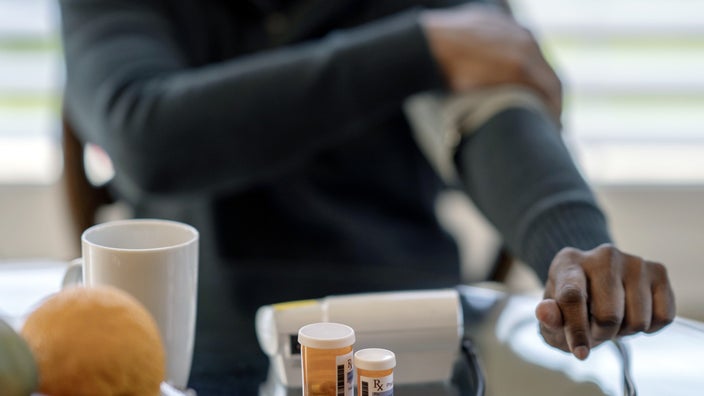
Lisinopril Dosages: Your GoodRx Guide
Key takeaways:
Lisinopril (Zestril, Qbrelis) is a prescription medication that treats high blood pressure, heart failure, and may lower the risk of death after a heart attack. It can also be used off-label to treat kidney damage from diabetes.
Usual doses of lisinopril range from 5 mg to 40 mg once daily. Often, your prescriber will start you at a lower dose of 2.5 mg to 5 mg per day, and increase it over time if needed.
Lisinopril tablets are available as lower-cost generics. GoodRx can help you save over 70% off the average retail price at certain pharmacies.
Table of contents

Lisinopril (Zestril, Qbrelis) is a medication that treats high blood pressure (hypertension) in adults and some children. It’s also approved to treat some other heart-related conditions. It’s part of a group of medications called angiotensin-converting enzyme (ACE) inhibitors.
In this guide, we’ll review typical lisinopril dosages. Keep in mind, these are the FDA-approved dosages; it’s possible that your prescriber will recommend a dose that’s different from what’s discussed here. If you have any questions about your lisinopril dosage, talk to your prescriber or pharmacist.
What’s the typical lisinopril dosage for adults?
Lisinopril comes as a tablet (Zestril) and oral solution (Qbrelis). The tablets are available in multiple strengths, ranging from 2.5 mg to 40 mg. The oral solution is available as a 1 mg/mL liquid.
Lisinopril is FDA approved to treat hypertension and heart failure. It can also be given after a heart attack to lower the risk of death. For each of these conditions, the lisinopril dosage is unique.
Talk to your prescriber or pharmacist about the best time of day to take lisinopril. While taking it in the morning is often recommended, it’s usually best to prioritize taking it at a time that you’ll remember to take it each day. Consistency is key with lisinopril.
Hypertension
ACE inhibitors like lisinopril are first-choice medications for hypertension. The typical lisinopril dosage for hypertension depends on many factors, including how high your current blood pressure is. It usually starts at 10 mg once daily. Your prescriber may increase your dose over time if your blood pressure is still too high.
Most people will end up taking 20 mg to 40 mg of lisinopril once daily. Though doses up to 80 mg daily may be used, it’s not clear if doses over 40 mg have any benefit. And higher doses could lead to more side effects.
If you’re taking other blood pressure medications like diuretics (water pills), you may need a lower lisinopril dosage.For example, lisinopril is often prescribed with hydrochlorothiazide (it’s even available as a combination tablet with hydrochlorothiazide called Zestoretic). In this case, your prescriber may start you at just 5 mg of lisinopril. This is because diuretics also decrease blood pressure. So starting with a lower lisinopril dosage helps prevent your blood pressure from dropping too low (hypotension).
Heart failure
When lisinopril is used to treat heart failure, it’s considered an “add-on” treatment. This means it’s prescribed along with other medications that treat heart failure (like diuretics).
The usual lisinopril dosage for heart failure starts at 5 mg once daily. If you have low sodium (salt) levels, which can happen in heart failure or from taking diuretics, your prescriber may start you at an even lower dose of 2.5 mg. This is because having low sodium levels (hyponatremia) is a risk factor for developing hypotension.
Over time, your prescriber may increase your dose up to a maximum of 40 mg once daily.
After a heart attack
Lisinopril may be prescribed to lower the risk of death following a heart attack. In fact, ACE inhibitors like lisinopril are recommended for most people following a heart attack. Lisinopril is usually prescribed within 24 hours of a heart attack. The typical dosing schedule is:
5 mg within 24 hours of a heart attack
Another 5 mg dose 24 hours after the heart attack
10 mg daily starting 24 hours after the second 5 mg dose (continued for at least 6 weeks)
Diabetic Nephropathy (off-label use)
The term diabetic nephropathy refers to kidney damage caused by diabetes. ACE inhibitors may be used off-label for this condition. In fact, they’re first-choice options for managing diabetic nephropathy in people with hypertension. And in people with diabetic nephropathy without hypertension, ACE inhibitors may still be beneficial.
If lisinopril is recommended, the recommended starting dose is usually 10 mg. The maximum dose is 40 mg.
ACE inhibitors can help slow down kidney damage, but the best lisinopril dosage for diabetic nephropathy isn’t clear. Experts recommend using the maximum dose that’s safe and doesn’t cause side effects.
What’s the typical lisinopril dosage for children?
Lisinopril is approved to treat hypertension in children who are at least 6 years old. The dosage is based on the child’s body weight in kilograms (kg).
The recommended starting dose is 0.07 mg/kg once daily, up to a maximum of 5 mg to start. Over time, your child’s prescriber may adjust the dose based on how their blood pressure responds to lisinopril. The maximum daily dose that can be used in children is 0.61 mg/kg, up to 40 mg daily.
How much does lisinopril lower blood pressure?
Research shows that higher doses of lisinopril tend to lower blood pressure more than smaller doses.
An older study of over 200 people found that higher doses of lisinopril decreased blood pressure more than lower doses. For example, lisinopril 5 mg decreased systolic blood pressure (the first/top number) by about 8 points. But lisinopril 20 mg decreased systolic blood pressure by about 14 points, and lisinopril 80 mg decreased it by about 20 points.
Besides this small study, most of the available research we have is on lisinopril 10 mg. Research indicates that lisinopril 10 mg once daily may decrease your systolic blood pressure by about 8 points.
While higher doses of lisinopril decrease blood pressure more than lower doses, it doesn’t mean that higher doses are the best option for you. Higher doses of lisinopril (like 80 mg per day) may decrease your blood pressure too much and cause hypotension. The best dose for you will depend on how high your blood pressure is and your individual blood pressure goals.
Are there any dosage adjustments for medical conditions?
If you have existing kidney problems, your prescriber may recommend a lower lisinopril dosage. In this case, the dosage will be based on your creatinine clearance (CrCl). CrCl is a lab test that’s used to predict how well your kidneys work. A lower CrCl may indicate that your kidneys are working less efficiently than what’s considered normal.
Lisinopril is not recommended for children with a CrCl less than 30 mL/minute. Initial lisinopril dosages for adults with lower kidney function are described below. If your CrCl is:
Greater than 30 mL/minute: No dosage adjustment is needed.
From 10 mL/minute to 30mL/minute: The typical starting dose is half of the usual starting dose. For example, someone with hypertension may start with lisinopril 5 mg instead of the usual 10 mg.
Less than 10 mL/minute or on dialysis: 2.5 mg daily.
The maximum recommended lisinopril dosage in people with kidney problems is 40 mg once daily.
Good to know: If you’re 65 years and older, you may be more likely to experience hypotension. Depending on whether you have other risk factors for hypotension, like taking high doses of diuretics or having heart disease, you may need a lower dose of lisinopril. Make sure your prescriber knows your full medical history so they can determine the best lisinopril dosage for you.
What happens if you miss a dose of lisinopril?
If you miss a dose of lisinopril, try to take it as soon as you remember.
But, if your next dose is coming up soon, skip the missed dose. In this case, simply take your next dose as usual at the regular scheduled time. Taking more than one dose of lisinopril at a time can cause hypotension.
Missing too many doses of lisinopril can cause your blood pressure to increase. If you miss multiple doses in a row, let your prescriber know. They may want you to check your blood pressure at home to make sure it’s not too high.
If you need help remembering to take your medication, there are a few tips that can help. Try working your lisinopril dose into your daily routine.
Here’s some tips you could try:
Taking lisinopril with the same meal each day
Placing your prescription bottle in a place you’ll always see it (like on your nightstand)
Using a reminder app if you have a smartphone
Placing sticky note reminder places you’ll see them, like on the fridge
What should you do if you take too much lisinopril?
Taking too much lisinopril can lead to severe hypotension. So if you think you’ve taken too much, it’s a good idea to contact your prescriber and let them know. They’ll likely ask some follow-up questions, including how much lisinopril you took and whether you’re experiencing symptoms.
Symptoms of hypotension may include dizziness, headache, and blurry vision. If you experience any of these symptoms, or you check your blood pressure and it’s low, contact your prescriber. If your symptoms are severe — including breathing quicker than normal or a weak pulse — seek immediate medical care.
How to save on lisinopril
GoodRx may be able to help you save over 80% off the average retail price of lisinopril. Generic lisinopril’s price at certain pharmacies may be as low as $9.37 with a free GoodRx discount.
You may also be able to save on brand-name Zestril and Qbrelis with a copay savings card from the manufacturer. If you have commercial insurance, you may be eligible to pay as little as $28 per month for Zestril and $30 per month for Qbrelis.
The bottom line
Lisinopril is prescribed to treat hypertension, heart failure, and kidney damage from diabetes (diabetic nephropathy). It’s also prescribed to help lower the risk of death after a heart attack.
The recommended lisinopril dosage depends on what you’re treating. Doses typically range from 5 mg to 40 mg once per day. Your prescriber will usually start you at a lower dose of 2.5 mg to 5 mg per day before increasing the dose as needed. Lisinopril dosages for children are based on body weight. Remembering to take your lisinopril dosage daily will help keep your blood pressure under control.
Why trust our experts?



References
Bryant Ranch Prepack. (2020). Lisinopril- lisinopril tablet [package insert].
Derington, C. G., et al. (2020). Twice-daily versus once-daily lisinopril and losartan for hypertension: Real-world effectiveness and safety. PloS One.
Ermasova, S. A., et al. (2022). Transient hypotension in elderly hypertensive patients: What and how to manage? e-Journal of Cardiology Practice.
Gomez, H. J., et al. (1989). Lisinopril dose-response relationship in essential hypertension. British Journal of Clinical Pharmacology.
Heran, B. S., et al. (2008). Blood pressure lowering efficacy of angiotensin converting enzyme (ACE) inhibitors for primary hypertension. Cochrane Database of Systematic Reviews.
Kidney Disease: Improving Global Outcomes (KDIGO) Diabetes Work Group. (2022). KDIGO 2022 clinical practice guideline for diabetes management in chronic kidney disease. Kidney International.
Latifi, A. N., et al. (2020). Use of guideline-directed medical therapy in patients with ST-elevation myocardial infarction. Cureus.
National Kidney Foundation. (n.d.). Creatinine.
National Kidney Foundation. (n.d.). Dialysis.
Tsai, T., et al. (2017). Efficacy and safety of twice- vs once-daily dosing of lisinopril for hypertension. Journal of Clinical Hypertension.
Whelton, P. K., et al. (2017). ACC/AHA/AAPA/ABC/ACPM/AGS/APhA/ASH/ASPC/NMA/PCNA guideline for the prevention, detection, evaluation, and management of high blood pressure in adults: A report of the American College of Cardiology/American Heart Association task force on clinical practice guidelines. Hypertension.
Was this page helpful?
Related Articles
Browse medications
View AllResearch prescriptions and over-the-counter medications from A to Z, compare drug prices, and start saving.




























